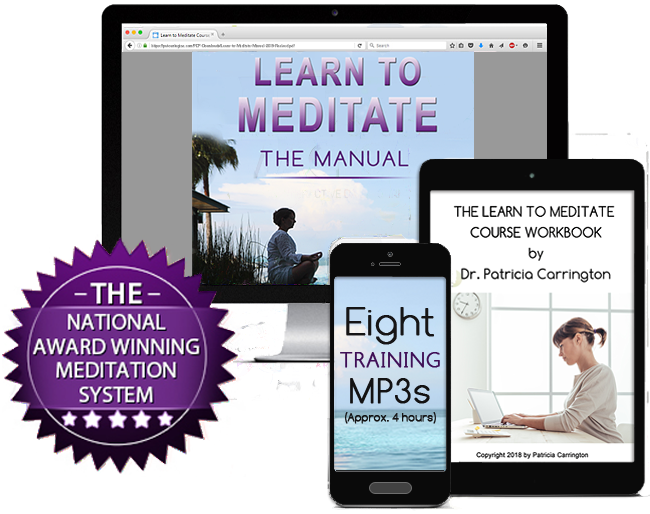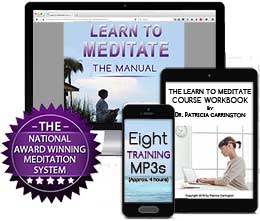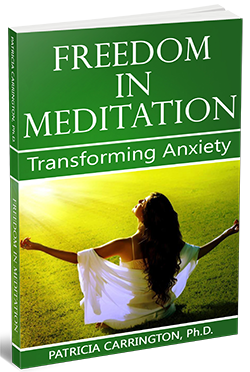Patricia Carrington, Ph.D.
Excerpt from “Freedom in Meditation”
The most technologically sophisticated of the relaxation techniques was developed in the 1950s. It does not rely on a mental device for obtaining its effects but on an electronic one. Biofeedback can be applied to brain waves as well as to other physiological systems to produce a relaxed state. A subject who is hooked up to an electroencephalograph (EEG) machine need only attend to a signal that goes on when their brain is producing a strong burst of the desired type of brain wave and with this information can usually learn to produce the desired brain-wave pattern on command, often within fifteen sessions or less.
This kind of biofeedback has important implications for the study of states of consciousness. Brain rhythms are characterized by their frequency – so many cycles or peaks per second. The alpha rhythm, measured from the back of the head, is between eight and twelve cycles per second. The beta rhythm is faster, between 18 and 30 cycles per second. These two kinds of brain wave are of particular interest to scientists because they seem to reflect specific mental states.
Alpha waves typically accompany drowsy, relaxed states where the mind is drifting in a somewhat unfocused manner. Subjects in the laboratory variously describe the alpha state as ‘relaxing’, ‘passive’, ‘anxious’, ‘letting go’, ‘submissive’, ‘high’, ‘pleasant’, and so on. Although it is not experienced in the same way by everyone, it is often present in abundance in the brainwave tracings of experienced meditators during their meditation, and sometimes outside of it as well.1
Theta is the state people reach just before sleep and some research even suggests that it may be the time when creative people receive some of their important inspirations.2 Like alpha, theta also appears in the brain-wave tracings of meditating persons, but usually only in very experienced meditators and following a previous period of alpha.3
What are the implications of these findings? Do they mean that a person can bypass meditation and achieve what has been jokingly referred to as ‘instant satori’ (enlightenment) simply by bringing about certain changes in their brain waves? At first this seemed as though it might be the case, and the public was eager to purchase the portable alpha biofeedback machines however, that alpha does not do all the things that had been promised. While meditation may produce alpha, going into alpha does not necessarily produce meditation. Apparently a meditative state is more than the mere sum of its accompanying brain waves!
According to Dr. Gary Schwartz, formerly of the Department of Human Relations at Harvard, 4 one of the most important things to realize when trying to influence various bodily systems is that they typically operate in patterns, something, which in the first flush of enthusiasm about biofeedback, may not have been properly appreciated. To take a single aspect of the body’s operation, such as heart rate or blood pressure or a particular brain-wave pattern, out of context and train it by itself to respond to a signal (as has usually been done in biofeedback) may be a ‘second-rate’ imitation of nature.
Schwartz found, for instance, that he could train a subject in his lab to reduce his blood pressure a few points in response to a signal sent to him whenever his blood pressure lowered itself even slightly, but if the subject was taught this and nothing else, his blood pressure would go down while his heart rate remained the same. Under natural conditions, however, we see lowered blood pressure accompanied by a slowed heart rate more than half the time.
Do these systems (heart rate and blood pressure) naturally link up because in a sense they ‘prefer’ to move together rather than singly? To find out, the Harvard researchers then rigged the biofeedback signal so that it sounded only when both blood pressure and heart rate were being lowered at the same time. When this was tried the results were clear: blood pressure fell more sharply when the subjects were responding to a blood pressure-plus-heart rate signal than when they were responding to a blood pressure-alone signal. The subjects were also able to learn more rapidly when their task was to move both blood pressure and heart rate in the same direction (whether this direction was up or down).
This and other research suggest that body systems operate more efficiently when acting in unison with one another than when acting alone. Since these systems are interrelated, a training procedure which gets to all of them at once and tries to move them as a whole, the way a chord is transposed in music to another octave, may be the most effective. Schwartz has gone so far as to suggest that perhaps the main importance of biofeedback will be its potential as a research tool rather than its use as a form of therapy. Biofeedback training can give us extremely important information about physiology which previously we have not been able to identify. When a change in the functioning of body systems is desired for health reasons, however, it may be easier to bring it about by methods which automatically stimulate a cluster of physiologic systems – the same systems that tend, in nature, to vary in a coordinated fashion. This is what seems to happen with methods such as meditation which automatically bring about full relaxation in many systems at the same time. It may be the harmony between a number of different bodily processes that is responsible for a state of maximum calm.
In light of this reasoning, it might be a wise strategy in the long run to find ways of understanding, using and encouraging the relaxation response of the human body as it occurs in nature, rather than imitating it by machines, and this can probably be done best by using the various mental techniques for relaxation. Among these techniques, meditation ranks high as an effective tool. For certain purposes, in fact, it may well be the most useful tool of all.
Looking back at the various techniques for personal growth reviewed in this chapter, we can see that virtually all of them require special conditions such as lowering of external stimulation or the presence of monotonous stimulation. In addition, every one of them sometimes evokes a meditative mood – with the possible exception of self-hypnosis, which only does so if the specific directions which the person gives himself are to ‘relax’.
Despite the fact that they often involve a meditative mood, however, none of the techniques seems to be the same as meditation. They do not set out purposely to create the non-striving, goal-less experience of meditation, and none seems to achieve it in quite the same manner. We might view meditation therefore as a method which is related to, but also different from, the other techniques for relaxation or personality growth.
Learn about Clinically Standardized Meditation
A Gentle, Easy-to-Learn, Form of Meditation
Clinically Standardized Meditation (CSM) is a clinically sensitive meditation method used by numerous medical institutions, organizations, and individuals worldwide.
1. B. B. Brown, New Mind, New Body (New York: Harper, 1974).
2. E. E. Green, A. M. Green and E. D. Walters, ‘Voluntary Control of Internal States’, Journal of Transpersonal Psychology, 2 (1970), pp. 1–25.
3. A. Kasamatsu and T. Hirai, ‘An Electroencephalographic Study on the Zen Meditation (Zazen)’, in Tart (ed.), op. cit., pp. 489–501..
4. G. Schwartz, ‘Biofeedback, Self-Regulation and the Patterning of Physiological Processes’, American Scientist, 63 (1975), pp. 314–24.








